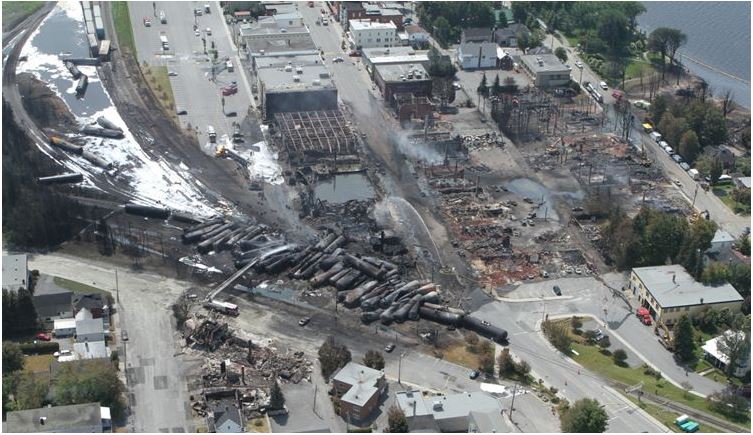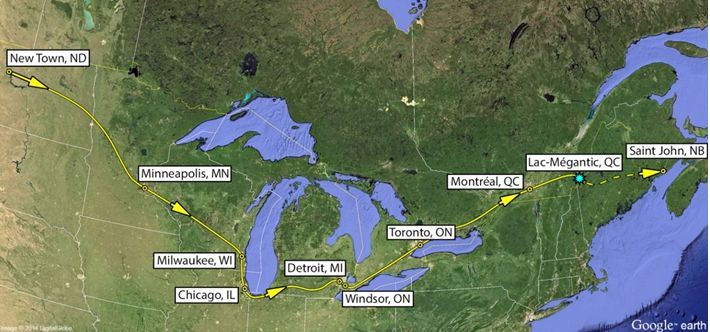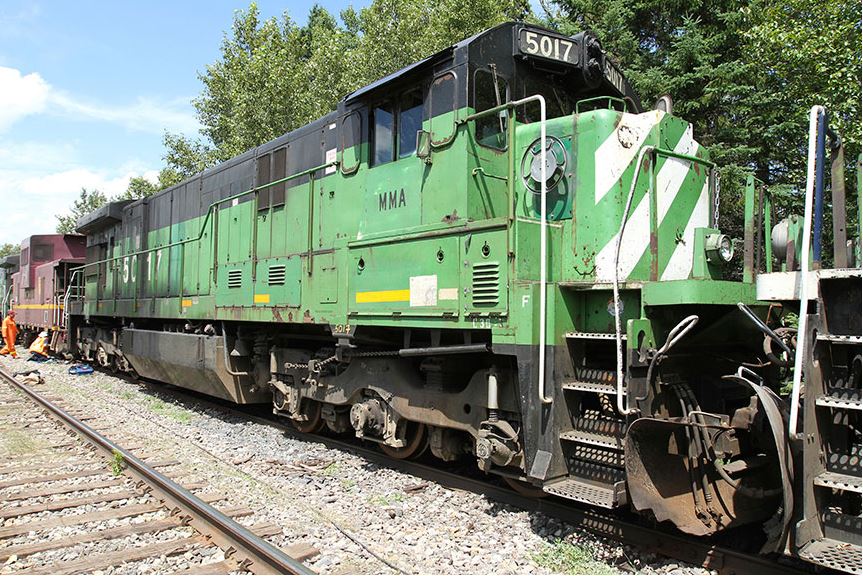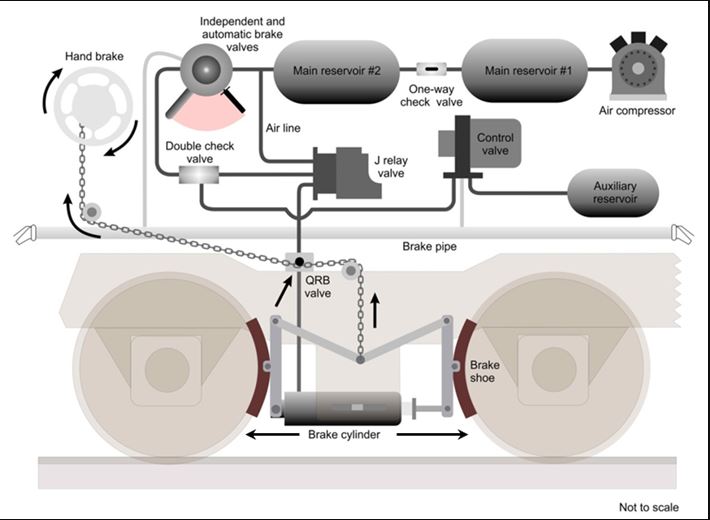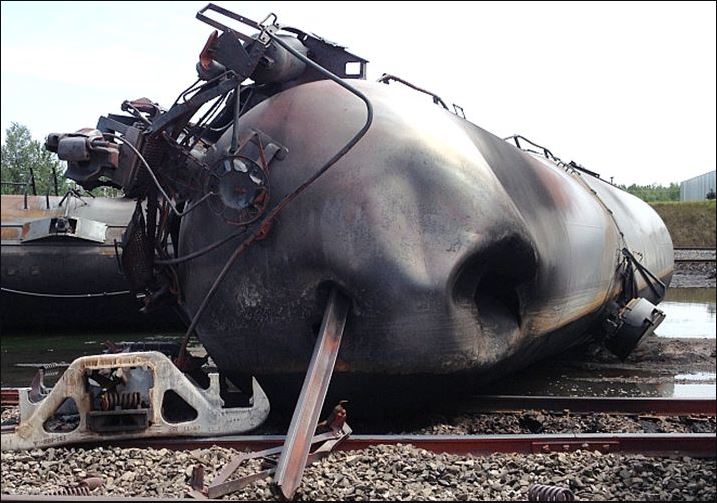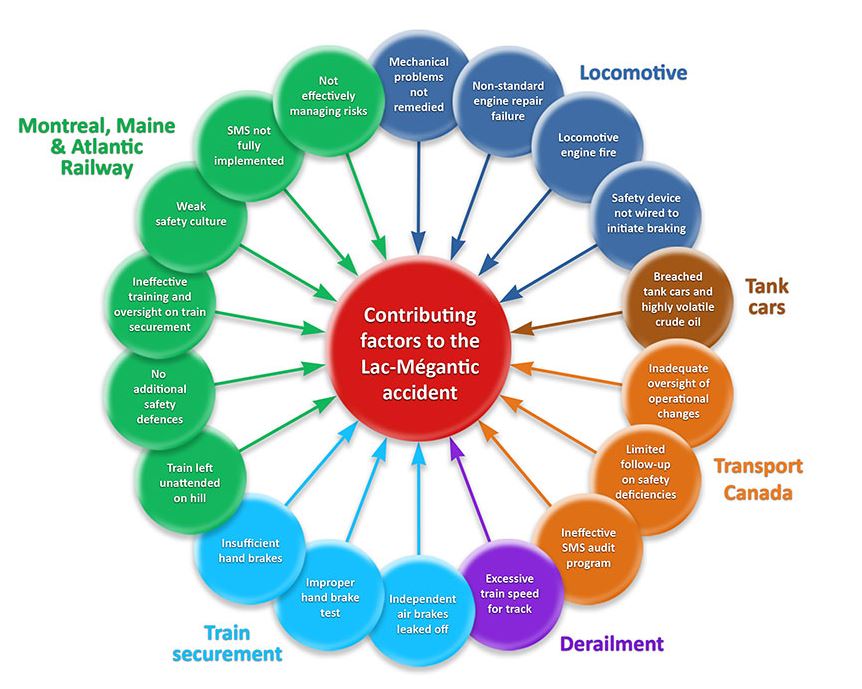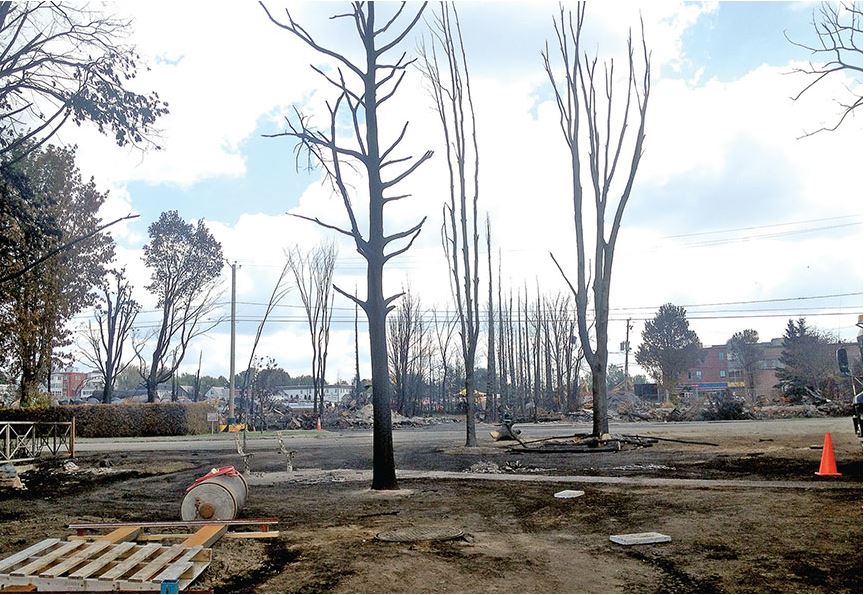This summary of the Transportation Safety Board of Canada's (TSB) Railway Investigation Report R13D0054 contains a description of the accident, along with an overview of the analysis and findings, the safety action taken to date, five key recommendations, and what more needs to be done to help ensure an accident like this does not happen again.
The accident
On the evening of July 5, 2013, at about 10:50 p.m., a Montreal, Maine & Atlantic Railway (MMA) train arrived at Nantes, Quebec, carrying 7.7 million litres of petroleum crude oil in 72 Class 111 tank cars. Originating in New Town, North Dakota, these were bound for Saint John, New Brunswick.
In keeping with the railway's practice, after arriving in Nantes, the locomotive engineer (engineer) parked the train on a descending grade on the main track. A replacement engineer was scheduled to continue the trip east in the morning.
The engineer applied hand brakes on all five locomotives and two other cars, and shut down all but the lead locomotive. Railway rules require hand brakes alone be capable of holding a train, and this must be verified by a test. That night, however, the locomotive air brakes were left on during the test, meaning the train was being held by a combination of hand brakes and air brakes. This gave the false impression that the hand brakes alone would hold the train.
The engineer then contacted the rail traffic controller in Farnham, Quebec, to advise that the train was secure. Next, the engineer contacted the rail traffic controller in Bangor, Maine, who controls movements for the crews east of Lac-Mégantic. During this conversation, the engineer indicated that the lead locomotive had experienced mechanical difficulties throughout the trip, and that excessive black and white smoke was coming from its smoke stack. Because they expected the smoke to settle, it was agreed to leave the train as it was and deal with the situation the next morning.
Shortly after the engineer left, the Nantes Fire Department responded to a 911 call reporting a fire on the train. After shutting off the locomotive's fuel supply, the firefighters moved the electrical breakers inside the cab to the off position, in keeping with railway instructions. They then met with an MMA employee, a track foreman who had been dispatched to the scene but who did not have a locomotive operations background.
Once the fire was extinguished, the firefighters and the track foreman discussed the train's condition with the rail traffic controller in Farnham, and departed soon afterward. With all the locomotives shut down, the air compressor no longer supplied air to the air brake system. As air leaked from the brake system, the main air reservoirs were slowly depleted, gradually reducing the effectiveness of the locomotive air brakes. Just before 1 a.m., the air pressure had dropped to a point at which the combination of locomotive air brakes and hand brakes could no longer hold the train, and it began to roll downhill toward Lac-Mégantic, just over seven miles away.
As it moved down the grade, the train picked up speed, reaching a top speed of 65 mph. It derailed near the centre of the town at about 1:15 a.m.
Aftermath and emergency response
Almost all of the 63 derailed tank cars were damaged, and many had large breaches. About six million litres of petroleum crude oil was quickly released. The fire began almost immediately, and the ensuing blaze and explosions left 47 people dead. Another 2000 people were forced from their homes, and much of the downtown core was destroyed.
The pileup of tank cars, combined with the large volume of burning petroleum crude oil, made the firefighters' job extremely difficult. Despite the challenges of a large emergency, the response was well coordinated, and the fire departments effectively protected the site and ensured public safety after the derailment.
Key issues in the investigation
This investigation looked at many issues to find out what happened, why it happened, and what needs to be done to prevent it from happening again. This section describes some of these key issues.
Fire in the locomotive
In October 2012, eight months before this accident, the lead locomotive was sent to MMA's repair shop following an engine failure. Given the significant time and cost of a standard repair, and the pressure to return the locomotive to service, the engine was repaired with an epoxy-like material that lacked the required strength and durability. This material failed in service, leading to engine surges and excessive black and white smoke. Eventually, oil began to accumulate in the body of the turbocharger, where it overheated and caught fire on the night of the accident.
Braking force
The Canadian Rail Operating Rules required that unattended equipment be left with a "sufficient" number of hand brakes applied to prevent movement, and that the effectiveness of the hand brakes be tested. MMA's rules called for a minimum of nine hand brakes for a 72-car train. These rules also required that a train's air brake system not be depended upon to prevent an undesired movement.
Even more crucial is the requirement to test the effectiveness of the hand brakes. That night, the engineer carried out the hand brake effectiveness test with the locomotive air brakes still applied. As a result, the test did not identify that an insufficient amount of hand brake force had been applied to secure the train.
The TSB concluded that, without the extra force provided by the air brakes, a minimum of 17 and possibly as many as 26 hand brakes would have been needed to secure the train, depending on the amount of force with which they had been applied.
Air brakes 101
Trains have two types of air brakes: automatic brakes and independent brakes.
Automatic air brakes are used to slow or stop the entire train, and are controlled by means of a brake pipe connected to each car and locomotive. Decreases in pressure within this pipe cause air to flow into each car's control valve, which injects stored air into the brake cylinder, applying the brake shoes to the wheels.
By contrast, independent air brakes are available only on locomotives. They are activated by the direct injection of air into their brake cylinders, which then apply the brake shoes to the wheels.
Both independent brakes and automatic brakes are supplied with air from a compressor on each locomotive. When a locomotive is shut off, the compressor no longer supplies the system with air.
When air leaks from the various components, the pressure in the brake cylinders gradually drops, and the amount of force being applied to the locomotive wheels by the independent brakes is reduced. Eventually, if the system is not recharged with air, the brakes will become ineffective and provide no braking force.
When the air brake control valves sense a drop in pressure in the brake pipe, they are designed to activate the brakes on each car. In this accident, however, the rate of leakage was slow and steady—approximately 1 pound per square inch per minute—and so the automatic brakes did not apply.
Hand brakes 101
In addition to air brake systems, all locomotives and rail cars are equipped with at least one hand brake. This is a mechanical device that applies brake shoes to the wheels to prevent them from moving.
The effectiveness of hand brakes depends on several factors, including their age, their maintained condition, their application in conjunction with air brakes, and the force exerted by the person applying the hand brake, which can vary widely.
Class 111 tank cars: Damage and construction
All 72 tanks cars were Class 111, manufactured between 1980 and 2012. Although they met requirements in effect at the time, they were built to an older standard, and they lacked enhancements such as a jacket, a full head shield, and thermal protection.
Almost every car that derailed was breached, some in multiple areas, including shells, heads, top and bottom fittings, and pressure relief devices. The exact location and extent of the damage varied depending on the orientation and speed of the cars during the derailment.
When the tank cars were breached, the petroleum crude oil was released, fuelling the fire. The damage to the tank cars could have been reduced by enhanced safety features. This is why the TSB called for tougher standards for tank cars carrying flammable liquids.
Safety culture at MMA
An organization with a strong safety culture is generally proactive when it comes to addressing safety issues. MMA was generally reactive. There were also significant gaps between the company's operating instructions and how work was done day to day. This and other signs in MMA's operations were indicative of a weak safety culture—one that contributed to the continuation of unsafe conditions and unsafe practices, and significantly compromised the company's ability to manage risk.
When the investigation looked carefully at MMA's operations, it found that employee training, testing, and supervision were not sufficient, particularly when it came to the operation of hand brakes and the securement of trains. Although MMA had some safety processes in place and had developed a safety management system in 2002, the company did not begin to implement this safety management system until 2010—and by 2013, it was still not functioning effectively.
Transport Canada
For several years, Transport Canada's regional office in Quebec had identified MMA as a company with an elevated level of risk that required more frequent inspections. Although MMA normally took corrective action once problems were identified, it was not uncommon for the same problems to reappear during subsequent inspections. These problems included issues with train securement, training, and track conditions. Transport Canada's regional office in Quebec, however, did not always follow up to ensure that these recurring problems were effectively analyzed and that the underlying conditions were fixed.
In addition, although MMA had developed a safety management system in 2002, Transport Canada's regional office in Quebec did not audit it until 2010—even though this is Transport Canada's responsibility, and despite clear indications (via inspections) that the company's safety management system was not effective. Transport Canada Headquarters in Ottawa, meanwhile, did not effectively monitor the Region's activities. As a result, it was not aware of any weaknesses in oversight of regional railways in Quebec, and it did not intervene.
Single-person crews
The TSB looked very carefully at single-person train operations, and at whether having just one crew member played a role in the accident. After looking at the circumstances that night, the investigation was not able to conclude that having another crew member would have prevented the accident.
However, there are some clear lessons for the system. If railways in Canada intend to implement single-person train operations, then they need to examine all the risks and make sure measures are in place to mitigate those risks. Transport Canada, for its part, should consider a process to approve and monitor the railways' plans so as to assure safety.
Dangerous goods: Inadequate testing, monitoring, and transport
The petroleum crude oil in the tank cars was more volatile than described on the shipping documents. If petroleum crude oil is not tested systematically and frequently, there is a risk of it being improperly classified. The movement of these improperly classified goods increases the risk to people, property, and the environment. That is why the TSB issued a safety advisory letter calling for changes.
Safety action following the accident
In the weeks and months after the accident, the TSB communicated critical safety information on the securement of unattended trains, the classification of petroleum crude oil, rail conditions at Lac-Mégantic, and the employee training programs of short line railways.
MMA, meanwhile, eliminated single-person train operations, stopped moving unit trains of petroleum crude oil, and increased operating-rules testing and enforcement.
For its part, Transport Canada introduced numerous initiatives, including an emergency directive prohibiting trains transporting dangerous goods from operating with single-person crews. Sections of the Canadian Rail Operating Rules were also rewritten, and new tank car standards have been proposed.
Considerable action was also undertaken in the United States. The National Transportation Safety Board issued recommendations aimed at route planning for hazardous materials trains, petroleum products response plans for worst-case spills, and the classification of hazardous materials. The U.S. Department of Transportation also issued an emergency order strengthening train securement rules, and a notice of proposed rulemaking targeting, among other items, improved tank car standards.
TSB Recommendations
In January 2014, the TSB made three recommendations aimed at addressing systemic safety issues that posed a significant risk. Three months later, it followed up to assess the action that had been taken by government and industry. In August 2014, the TSB made two additional recommendations.
| Recommendation | Status |
|---|---|
| R14-05 (August 2014) Transport Canada must take a more hands-on role when it comes to railways' safety management systems—making sure not just that they exist, but that they are working and that they are effective. | NEW |
| R14-04 (August 2014) Canadian railways must put in place additional physical defences to prevent runaways. | NEW |
| R14-03 (January 2014) Emergency response assistance plans must be created when large volumes of liquid hydrocarbons, like oil, are shipped. | Fully Satisfactory (June 2014) |
| R14-02 (January 2014) Railway companies should conduct strategic route-planning and enhance train operations for all trains carrying dangerous goods. | Satisfactory IntentRailways must make progress on the development and implementation of new rules to improve their operating practices for the safe transportation of dangerous goods. (June 2014) |
| R14-01 (January 2014) Enhanced protection standards must be put in place for Class 111 tank cars. | Satisfactory in PartAlthough progress has been made, more work is required. All older Class 111 tank cars must not transport flammable liquids, and a more robust tank car standard with enhanced protection must be set for North America (July 2014) |
Findings
Investigations conducted by the TSB are complex—an accident is never caused by just one factor. This report identifies 18 distinct causes and contributing factors, many of them influencing one another.
This report also contains 16 findings as to risk. Although these did not lead directly to the accident, they are related to unsafe acts, unsafe conditions, or safety issues with the potential to degrade rail safety. Some of the risks that need to be addressed are:
- the continuing risk of leaving trains unattended
- the risk of implementing single-person train operations
- the risk of not systematically testing petroleum crude oil
- the risk of not planning and analyzing routes on which dangerous goods are carried
- the risk of not having emergency response assistance plans in place
- the risk of Transport Canada not ensuring that safety management systems work effectively
Conclusion
The tragedy in Lac-Mégantic was not caused by one single person, action or organization. Many factors played a role, and addressing the safety issues will take a concerted effort from regulators, railways, shippers, tank car manufacturers, and refiners in Canada and the United States. Although this investigation is complete, the TSB will continue to monitor the five recommendations, and to report publicly on any progress—or lack of progress—until all of the safety deficiencies have been corrected.
